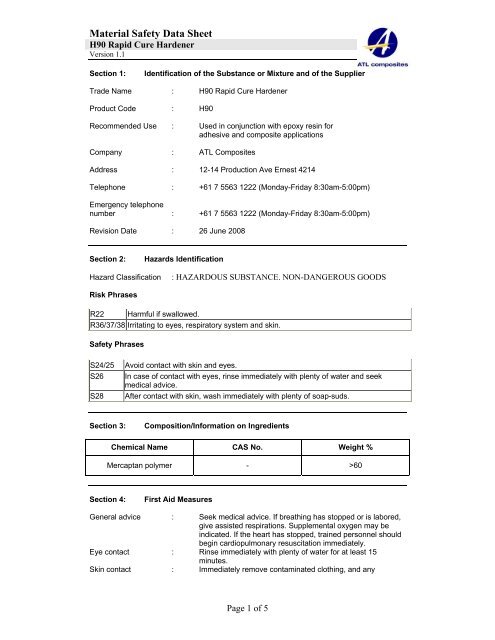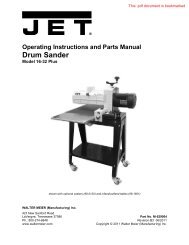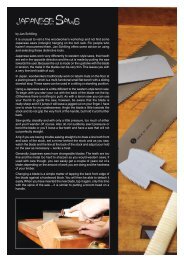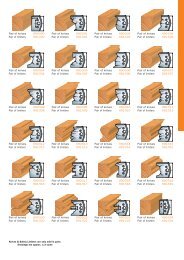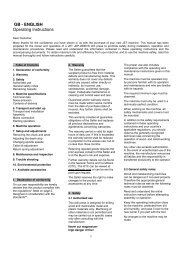Material Safety Data Sheet - Carba-Tec
Material Safety Data Sheet - Carba-Tec
Material Safety Data Sheet - Carba-Tec
Create successful ePaper yourself
Turn your PDF publications into a flip-book with our unique Google optimized e-Paper software.
<strong>Material</strong> <strong>Safety</strong> <strong>Data</strong> <strong>Sheet</strong><br />
H90 Rapid Cure Hardener<br />
Version 1.1<br />
Section 1:<br />
Identification of the Substance or Mixture and of the Supplier<br />
Trade Name : H90 Rapid Cure Hardener<br />
Product Code : H90<br />
Recommended Use : Used in conjunction with epoxy resin for<br />
adhesive and composite applications<br />
Company : ATL Composites<br />
Address : 12-14 Production Ave Ernest 4214<br />
Telephone : +61 7 5563 1222 (Monday-Friday 8:30am-5:00pm)<br />
Emergency telephone<br />
number : +61 7 5563 1222 (Monday-Friday 8:30am-5:00pm)<br />
Revision Date : 26 June 2008<br />
Section 2:<br />
Hazards Identification<br />
Hazard Classification<br />
: HAZARDOUS SUBSTANCE. NON-DANGEROUS GOODS<br />
Risk Phrases<br />
R22 Harmful if swallowed.<br />
R36/37/38 Irritating to eyes, respiratory system and skin.<br />
<strong>Safety</strong> Phrases<br />
S24/25 Avoid contact with skin and eyes.<br />
S26 In case of contact with eyes, rinse immediately with plenty of water and seek<br />
medical advice.<br />
S28 After contact with skin, wash immediately with plenty of soap-suds.<br />
Section 3:<br />
Composition/Information on Ingredients<br />
Chemical Name CAS No. Weight %<br />
Mercaptan polymer - >60<br />
Section 4:<br />
First Aid Measures<br />
General advice : Seek medical advice. If breathing has stopped or is labored,<br />
give assisted respirations. Supplemental oxygen may be<br />
indicated. If the heart has stopped, trained personnel should<br />
begin cardiopulmonary resuscitation immediately.<br />
Eye contact : Rinse immediately with plenty of water for at least 15<br />
minutes.<br />
Skin contact : Immediately remove contaminated clothing, and any<br />
Page 1 of 5
<strong>Material</strong> <strong>Safety</strong> <strong>Data</strong> <strong>Sheet</strong><br />
H90 Rapid Cure Hardener<br />
Version 1.1<br />
extraneous chemical, if possible to do so without delay. Take<br />
off contaminated clothing and shoes immediately.<br />
NOTE TO PHYSICIANS : Application of corticosteroid cream has been effective in<br />
treating skin irritation.<br />
Ingestion : Never give anything by mouth to an unconscious person.<br />
Prevent aspiration of vomit. Turn victim's head to the side.<br />
Inhalation : Move to fresh air.<br />
Section 5:<br />
Fire Fighting Measures<br />
Suitable extinguishing media : Alcohol-resistant foam.<br />
Carbon dioxide (CO2).<br />
Dry chemical.<br />
Dry sand.<br />
Limestone powder.<br />
Specific hazards : Do not allow run-off from fire fighting to enter drains or water<br />
courses. Incomplete combustion may form carbon monoxide.<br />
Downwind personnel must be evacuated. Burning produces<br />
obnoxious and toxic fumes.<br />
Special protective equipment<br />
for fire-fighters : Avoid contact with the skin. Use personal protective<br />
equipment. Wear self contained breathing apparatus for fire<br />
fighting if necessary.<br />
Section 6:<br />
Accidental Release Measures<br />
Personal precautions<br />
Use self-contained breathing apparatus and chemically<br />
protective clothing.<br />
Wear suitable protective clothing, gloves and eye/face<br />
protection. Evacuate personnel to safe areas.<br />
Environmental precautions : Construct a dike to prevent spreading.<br />
Methods for cleaning up : Approach suspected leak areas with caution. Place in<br />
appropriate chemical waste container.<br />
Additional advice : If possible, stop flow of product.<br />
Section 7:<br />
Handling and Storage<br />
Handling<br />
Advice on safe handling :<br />
Do not get in eyes, on skin or on clothing. Use only with<br />
adequate ventilation. Avoid contact with skin, eyes and<br />
clothing. Avoid prolonged or repeated contact with skin, eyes<br />
and clothing. Wash thoroughly after handling. May be<br />
harmful if swallowed. Causes respiratory tract irritation.<br />
Containers, even those that have been emptied, can contain<br />
hazardous product residues. Wash with soap and water<br />
before eating, drinking, smoking, applying cosmetics, or<br />
using toilet facilities. Launder contaminated clothing before<br />
reuse. Contaminated leather articles, including shoes, cannot<br />
be decontaminated and should be destroyed to prevent<br />
reuse.<br />
Storage<br />
Requirements for storage<br />
areas and containers : Keep containers closed when not in use.<br />
Page 2 of 5
<strong>Material</strong> <strong>Safety</strong> <strong>Data</strong> <strong>Sheet</strong><br />
H90 Rapid Cure Hardener<br />
Version 1.1<br />
Section 8:<br />
Exposure Controls / Personal Protection<br />
Workplace exposure standards: No exposure standards have been established for product<br />
components.<br />
Engineering measures Provide readily accessible eye wash stations and safety<br />
showers.<br />
Provide natural or explosion-proof ventilation adequate to<br />
ensure concentrations are kept below exposure limits.<br />
Personal protective equipment:<br />
Respiratory protection : Not required for properly ventilated areas.<br />
Hand protection : Neoprene gloves.<br />
PVC disposable gloves<br />
Butyl-rubber<br />
Nitrile rubber.<br />
Impervious gloves.<br />
The breakthrough time of the selected glove(s) must be<br />
greater than the intended use period.<br />
Eye protection : Chemical resistant goggles must be worn.<br />
Skin and body protection :<br />
Long sleeve shirts and trousers without cuffs.<br />
Impervious clothing.<br />
Environmental exposure<br />
Controls : Construct a dike to prevent spreading.<br />
Special instructions for<br />
protection and hygiene:<br />
Discard contaminated leather articles. Provide readily<br />
accessible eye wash<br />
stations and safety showers. Wash at the end of each<br />
workshift and before eating, smoking or using the toilet.<br />
Remove contaminated clothing. Drench<br />
affected area with water for at least 15 minutes<br />
Section 9:<br />
Physical and Chemical Properties<br />
Form : Viscous liquid<br />
Colour : Water white to light amber<br />
Odour : Strong<br />
pH : Not available<br />
Melting Point : Not Determined<br />
Boiling Point : >100°C<br />
Flash Point : >108°C<br />
Vapour Pressure : < 1 mmHg @20°C<br />
Density : 1.08 to 1.20<br />
Solubility in water : Slight<br />
Page 3 of 5
<strong>Material</strong> <strong>Safety</strong> <strong>Data</strong> <strong>Sheet</strong><br />
H90 Rapid Cure Hardener<br />
Version 1.1<br />
Section 10:<br />
Stability and Reactivity<br />
Conditions to avoid : Extremes of temperature and direct sunlight.<br />
Exposure to water vapour.<br />
<strong>Material</strong>s to avoid : Strong oxidizing agents.<br />
Strong acids.<br />
Hazardous decomposition<br />
Products : Oxides of nitrogen<br />
Carbon monoxide<br />
Hazardous reactions : Stable.<br />
Reacts violently with strong oxidising agents.<br />
Section 11:<br />
Toxicological Information<br />
Acute oral toxicity : LD50 - (Rat) Expected to be of low toxicity, LD50 > 2000<br />
mg/kg.<br />
Acute dermal toxicity : Expected to be of low toxicity, LD50 > 2000 mg/kg.<br />
Acute inhalation toxicity : Inhalation of vapours or mists may cause irritation.<br />
Eye irritation : Expected to be irritant.<br />
Skin irritation : Expected to be irritant.<br />
Sensitization : Not a sensitizer.<br />
Potential Health Effects<br />
Inhalation : Mists or vapors may produce severe respiratory irritation.<br />
Skin : May be mildly irritating to the skin.<br />
Eyes : May be severely irritating to the eyes and may cause severe<br />
damage including blindness.<br />
Vapors may also be irritating<br />
Ingestion : Not likely to be a relevant route of exposure.<br />
May be irritating to the mouth, throat, and stomach.<br />
Aggravated Medical<br />
Condition : Preexisting eye,skin and respiratory disorders may be<br />
aggravated by exposure to this product.<br />
Section 12:<br />
Ecological Information<br />
Aquatic toxicity : No data is available on the product itself.<br />
Toxicity to other organisms : No data available.<br />
Persistence and degradability<br />
Mobility : No data available.<br />
Bioaccumulation : No data is available on the product itself.<br />
Section 13:<br />
Disposal Considerations<br />
Waste from residues / unused<br />
Products : Contact supplier if guidance is required.<br />
Contaminated packaging : Dispose of container and unused contents in accordance<br />
with federal, state, and local requirements.<br />
Section 14:<br />
Transport Information<br />
ROAD & RAIL TRANSPORT:<br />
This product is not classified as a dangerous<br />
good for road and rail transport in the<br />
Page 4 of 5
<strong>Material</strong> <strong>Safety</strong> <strong>Data</strong> <strong>Sheet</strong><br />
H90 Rapid Cure Hardener<br />
Version 1.1<br />
Australian Dangerous Goods Code (ADG). The<br />
principal component is not included in the<br />
lists of Environmentally Hazardous Substances<br />
included in Appendix 8 of the 6th Edition of<br />
the ADG Code.<br />
ADG U.N. Number<br />
ADG Proper Shipping<br />
Name<br />
ADG DG Class<br />
ADG Hazchem Code<br />
ADG Packing Group<br />
None Allocated<br />
None Allocated<br />
None Allocated<br />
3X<br />
None Allocated<br />
Other Information:<br />
CFR_ROAD<br />
NOT REGULATED FOR TRANSPORT<br />
IATA_C<br />
NOT REGULATED FOR TRANSPORT<br />
IMDG<br />
NOT REGULATED FOR TRANSPORT<br />
CFR_RAIL<br />
NOT REGULATED FOR TRANSPORT<br />
Section 15:<br />
Regulatory Information<br />
The principal components and additives of this<br />
product are included in the Australian<br />
Inventory of Chemical Substances (AICS) or<br />
comply with the requirements of the Industrial<br />
Chemicals (Notification and Assessment) Act 1989.<br />
Poisons 5<br />
Schedule<br />
Hazard<br />
Category<br />
Packaging &<br />
Labelling<br />
HAZARDOUS SUBSTANCES<br />
CLASSIFICATION: Irritant.<br />
Product is labelled in accordance with the Code<br />
of Practice for Labelling Workplace Substances.<br />
Section 16:<br />
Other Information<br />
Contact<br />
Person/Point<br />
PRODUCT INFORMATION MANAGER: (+61) 7 5563 1222<br />
12-14 Production Av Ernest<br />
The information provided in this <strong>Safety</strong> <strong>Data</strong> <strong>Sheet</strong> is correct to the best of our knowledge, information and<br />
belief at the date of its publication. The information given is designed only as a guidance for safe handling,<br />
use, processing, storage, transportation, disposal and release and is not to be considered a warranty or quality<br />
specification. The information relates only to the specific material designated and may not be valid for such<br />
material used in combination with any other materials or in any process, unless specified in the text.<br />
Page 5 of 5
<strong>Material</strong> <strong>Safety</strong> <strong>Data</strong> <strong>Sheet</strong><br />
R90 Rapid Cure Epoxy Resin<br />
Version 3<br />
Section 1:<br />
Identification of the <strong>Material</strong> and the Supplier<br />
Trade Name : R90 Rapid Cure Epoxy Resin<br />
Product Code : R90<br />
Recommended Use : Used in conjunction with epoxy curing agent for<br />
adhesive and composite applications<br />
Company : ATL Composites<br />
Address : 12-14 Production Ave Ernest 4214<br />
Telephone : +61 7 5563 1222 (Monday-Friday 8:30am-5:00pm)<br />
Emergency telephone<br />
number : +61 7 5563 1222 (Monday-Friday 8:30am-5:00pm)<br />
Revision Date : 19 August 2011<br />
Section 2:<br />
Hazards Identification<br />
HAZARDOUS SUBSTANCES CLASSIFICATION: Classified as hazardous to health<br />
according to the criteria of the National Occupational Health and <strong>Safety</strong> Commission,<br />
Australia<br />
Non Dangerous Goods for transport according to ADG-7 (Special Provision AU01)<br />
Hazard Symbol<br />
Xi Irritant<br />
N<br />
Dangerous for the environment<br />
Risk Phrases<br />
R36/38 Irritating to eyes and skin.<br />
R43<br />
May cause sensitisation by skin contact.<br />
R51/53 Toxic to aquatic organisms, may cause long-term adverse effects in the aquatic<br />
environment.<br />
<strong>Safety</strong> Phrases<br />
S24 Avoid Contact with skin<br />
S28 After contact with skin, wash immediately with plenty of soap-suds.<br />
S37/39 Wear suitable gloves and eye / face protection.<br />
S61 Avoid release to the environment. Refer to special instructions/ safety datasheet.<br />
Section 3:<br />
Composition / Information on Ingredients<br />
Chemical Name CAS No. Weight %<br />
Reaction product: bisphenol-<br />
A-(epichlorhydrin); epoxy<br />
resin (number average<br />
molecular weight 60<br />
Page 1 of 6
<strong>Material</strong> <strong>Safety</strong> <strong>Data</strong> <strong>Sheet</strong><br />
R90 Rapid Cure Epoxy Resin<br />
Version 3<br />
Section 4:<br />
First Aid Measures<br />
Inhalation : Remove victim to fresh air and provide oxygen if breathing is<br />
difficult. Give artificial respiration if not breathing. Get medical<br />
attention.<br />
Skin contact : Remove contaminated clothing/shoes and wipe excess from<br />
skin. Flush skin with water. Follow by washing with soap and<br />
water. If irritation occurs, get medical attention. Do not reuse<br />
clothing until cleaned. Contaminated leather articles,<br />
including shoes, cannot be decontaminated and should be<br />
destroyed to prevent reuse.<br />
Eye contact : Flush eyes with plenty of water for 15 minutes while holding<br />
eyelids open. Get medical attention.<br />
Ingestion : Do not induce vomiting. In general, no treatment is<br />
Necessary unless large quantities of product are ingested.<br />
However, get medical advice.<br />
Workplace facilities : Eye wash facilities required.<br />
Skin cleaning products should be made available.<br />
Notes to physician : Irritation of the skin and eyes<br />
Symptoms<br />
Treatment : Treat symptomatically. Dermatitis may result from prolonged<br />
or repeated exposure.<br />
Section 5:<br />
Fire Fighting Measures<br />
Specific hazards during fire<br />
Fighting :<br />
Not classified as flammable but will burn. Hazardous<br />
combustion products may include carbon monoxide.<br />
Clear fire area of all non-emergency personnel. Cool fire<br />
exposed containers with water. Container areas exposed to<br />
direct flame contact should be cooled with large quantities of<br />
water as needed to prevent weakening of container structure.<br />
Suitable extinguishing<br />
media:<br />
Special protective<br />
equipment for fire-fighters:<br />
Use water fog, foam, dry chemical or carbon dioxide.<br />
Do not enter confined fire space without full bunker gear<br />
(helmet with face shield, bunker coats, gloves and rubber<br />
boots). including a positive pressure NIOSH approved<br />
selfcontained breathing apparatus.<br />
Section 6:<br />
Accidental Release Measures<br />
Personal precautions : May burn although not readily ignitable.<br />
Use cautious judgement when cleaning up large spills.<br />
Shut off leaks, if possible without personal risk.<br />
Environmental precautions:<br />
Dike and contain.<br />
Contain run-off and dispose of properly.<br />
Page 2 of 6
<strong>Material</strong> <strong>Safety</strong> <strong>Data</strong> <strong>Sheet</strong><br />
R90 Rapid Cure Epoxy Resin<br />
Version 3<br />
Clean-up methods - small<br />
spillage:<br />
Clean-up methods – large<br />
spillage:<br />
Remove contaminated soil to remove contaminated trace<br />
residues. Prevent from entering into drains, ditches or rivers.<br />
Soak up with an absorbent such as clay, sand or other<br />
suitable material.<br />
Place in non-leaking container.<br />
Seal tightly for proper disposal.<br />
Remove with vacuum trucks or pump to storage/salvage<br />
vessels.<br />
Soak up residue with an absorbent such as clay, sand or<br />
other suitable material; place in non-leaking containers for<br />
proper disposal.<br />
Flush area with water to remove trace residue.<br />
Section 7:<br />
Handling and Storage<br />
Advice on safe handling :<br />
Storage<br />
Requirements for storage<br />
areas and containers:<br />
Avoid prolonged or repeated contact with skin, eyes and<br />
clothing Avoid contact with skin, eyes and clothing Wash<br />
thoroughly after handling. WARNING. May cause skin and<br />
eye irritation. May cause skin sensitization.<br />
Wash with soap and water before eating, drinking, smoking,<br />
applying cosmetics, or using toilet facilities. Launder<br />
contaminated clothing before reuse. Contaminated leather<br />
articles, including shoes, cannot be decontaminated and<br />
should be destroyed to prevent reuse.<br />
Store in a cool, dry place with adequate ventilation. Keep<br />
containers closed when not in use. Keep away from open<br />
flames and high temperatures.<br />
Section 8:<br />
Exposure Controls / Personal Protection<br />
Workplace exposure standards: No exposure standards have been established for product<br />
components.<br />
Protective measures : Wear protective clothing specified for normal operations.<br />
Eye protection : Avoid contact with eyes.<br />
Wear chemical goggles if there is potential contact with eyes.<br />
<strong>Safety</strong> spectacles<br />
Hand protection : Butyl<br />
EVAL-Laminate<br />
Skin and body protection:<br />
Respiratory protection :<br />
Wear chemical-resistant gloves and other clothing as<br />
required to minimise contact.<br />
No respiratory protection is usually required under normal<br />
conditions of use. Product is not intended for spray<br />
application.<br />
Section 9:<br />
Physical and Chemical Properties<br />
Form : Liquid<br />
Page 3 of 6
<strong>Material</strong> <strong>Safety</strong> <strong>Data</strong> <strong>Sheet</strong><br />
R90 Rapid Cure Epoxy Resin<br />
Version 3<br />
Colour : Pale Yellow<br />
Odour : Mild<br />
pH : Not available<br />
Melting Point : Not Determined<br />
Boiling Point : >200°C<br />
Flash Point : >100°C (ASTM D-93 / PMCC)<br />
Vapour Pressure : Heavier than air.<br />
Density : 1.14 to 1.20<br />
Solubility in water : Not miscible<br />
Section 10:<br />
Stability and Reactivity<br />
Conditions to avoid : Avoid high temperatures.<br />
<strong>Material</strong>s to avoid : Can react vigorously with strong oxidizing agents, strong<br />
lewis or mineral acid, and strong mineral and organic bases.<br />
Avoid contact with water or liquids.<br />
Do not allow molten product to contact water or other liquids.<br />
Reaction with some curing agents may produce considerable<br />
heat and possible violent decomposition.<br />
Hazardous reactions : Stable under normal use conditions.<br />
Hazardous polymerization will not occur.<br />
Section 11:<br />
Toxicological Information<br />
Acute oral toxicity : LD50 - Low toxicity, LD50 > 2000 mg/kg.<br />
Acute dermal toxicity : LD50 - Low toxicity, LD50 > 2000 mg/kg.<br />
Acute inhalation toxicity : LC50 - Expected to be of low toxicity, LC50 > 5 mg/l., If mists<br />
are inhaled, slight irritation of the respiratory tract may occur.<br />
Eye irritation : Slightly irritating to the eyes.<br />
Skin irritation : Expected to be irritant.<br />
Sensitization : Skin sensitiser.<br />
Repeated dose toxicity : Repeated exposure does not cause significant toxic effects.<br />
Carcinogenicity : Recent 2-year bioassays in rats and mice exposed by the<br />
dermal route to the diglycidyl ether of bisphenol A (BADGE)<br />
yielded no evidence of carcinogenicity to the skin or any<br />
other organs.<br />
Potential Health Effects<br />
Inhalation : Not expected to be a relevant route of exposure, however,<br />
under conditions where exposure to vapors or mists is<br />
possible, could cause respiratory tract irritation.<br />
Skin : May be mildly irritating to the skin.<br />
Page 4 of 6
<strong>Material</strong> <strong>Safety</strong> <strong>Data</strong> <strong>Sheet</strong><br />
R90 Rapid Cure Epoxy Resin<br />
Version 3<br />
May cause skin sensitization.<br />
Eyes : May be mildly irritating to the eyes.<br />
Ingestion : Not likely to be a relevant route of exposure.<br />
Section 12:<br />
Ecological Information<br />
ENVIRONMENTAL FATE<br />
MOVEMENT & PARTITIONING: Bioconcentration potential is moderate (BCF between 100<br />
and 3000 or Log Pow between 3 and 5). Measured log<br />
octanol/water partition coefficient (log Pow) is 3.7-3.9.<br />
Potential for mobility in soil is low (Koc between 500 and<br />
2000). Soil organic carbon/water partition coefficient (Koc) is<br />
estimated to be 1800-4400. Henry's Law Constant (H) is<br />
estimated to be 100 mg/L.<br />
Section 13:<br />
Disposal Considerations<br />
DISPOSAL : DO NOT DUMP INTO ANY SEWERS, ON THE GROUND,<br />
OR INTO ANY BODY OF WATER. All disposal methods<br />
must be in compliance with all Federal, State/Provincial and<br />
local laws and regulations.<br />
FOR UNUSED & UNCONTAMINATED PRODUCT, the<br />
preferred options include sending to a licensed, permitted:<br />
recycler, reclaimer, incinerator or other thermal destruction<br />
device.<br />
Page 5 of 6
<strong>Material</strong> <strong>Safety</strong> <strong>Data</strong> <strong>Sheet</strong><br />
R90 Rapid Cure Epoxy Resin<br />
Version 3<br />
Section 14:<br />
Transport Information<br />
Not subject fo the ADG Code when transported by Road or Rail. (ADG 7, Special<br />
Provision AU01)<br />
IMDG/IATA<br />
Proper Shipping Name : Environmentally hazardous substance,<br />
liquid, n.o.s<br />
UN Number : 3082<br />
Class : 9<br />
Subsidiary risk : None assigned<br />
EPG card : 8A1<br />
Packaging group : III<br />
HAZCHEM CODE : 3Z<br />
Section 15:<br />
Regulatory Information<br />
The principal components and additives of this<br />
product are included in the Australian<br />
Inventory of Chemical Substances (AICS) or<br />
comply with the requirements of the Industrial<br />
Chemicals (Notification and Assessment) Act 1989.<br />
Poisons<br />
Schedule<br />
Hazard<br />
Category<br />
Packaging &<br />
Labelling<br />
S5<br />
HAZARDOUS SUBSTANCES<br />
CLASSIFICATION: Irritant. Sensitiser.<br />
Product is labelled in accordance with the Code<br />
of Practice for Labelling Workplace Substances.<br />
Section 16:<br />
Other Information<br />
Contact<br />
Person/Point<br />
PRODUCT INFORMATION MANAGER: (+61) 7 5563 1222<br />
12-14 Production Av Ernest<br />
The information provided in this <strong>Safety</strong> <strong>Data</strong> <strong>Sheet</strong> is correct to the best of our knowledge, information and<br />
belief at the date of its publication. The information given is designed only as a guidance for safe handling,<br />
use, processing, storage, transportation, disposal and release and is not to be considered a warranty or quality<br />
specification. The information relates only to the specific material designated and may not be valid for such<br />
material used in combination with any other materials or in any process, unless specified in the text.<br />
Page 6 of 6


